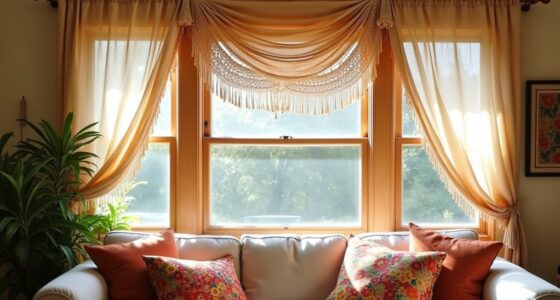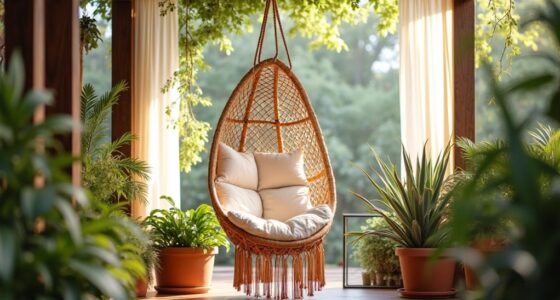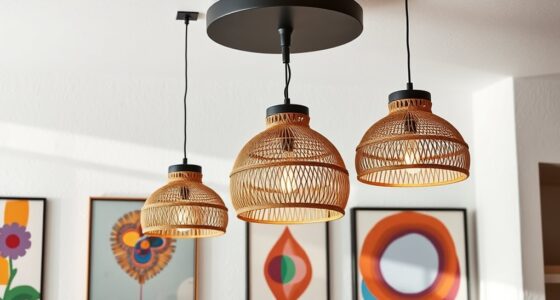To eco-friendly upgrade your boho home, start by choosing reclaimed wood, natural fibers, and sustainable textiles like hemp or organic cotton for decor. Install smart thermostats and energy-efficient LED lights to cut energy use. Incorporate solar outdoor lighting and rainwater harvesting for outdoor spaces. DIY projects like upcycling pallets or repurposing containers boost sustainability. Supporting local suppliers and eco-certifications guarantees responsible sourcing. Keep exploring for more tips to create a stylish, eco-conscious sanctuary.
Key Takeaways
- Incorporate reclaimed wood and salvaged furniture for rustic charm and reduced environmental impact.
- Use energy-efficient lighting like LEDs, motion sensors, and smart thermostats to lower energy consumption.
- Opt for natural, biodegradable textiles made from organic fibers for decor, cushions, and rugs.
- Install solar-powered outdoor lighting and rainwater harvesting systems to promote renewable energy use.
- Support local artisans and choose eco-certified, sustainable materials to ensure responsible sourcing and long-term sustainability.
Incorporating Reclaimed and Natural Materials
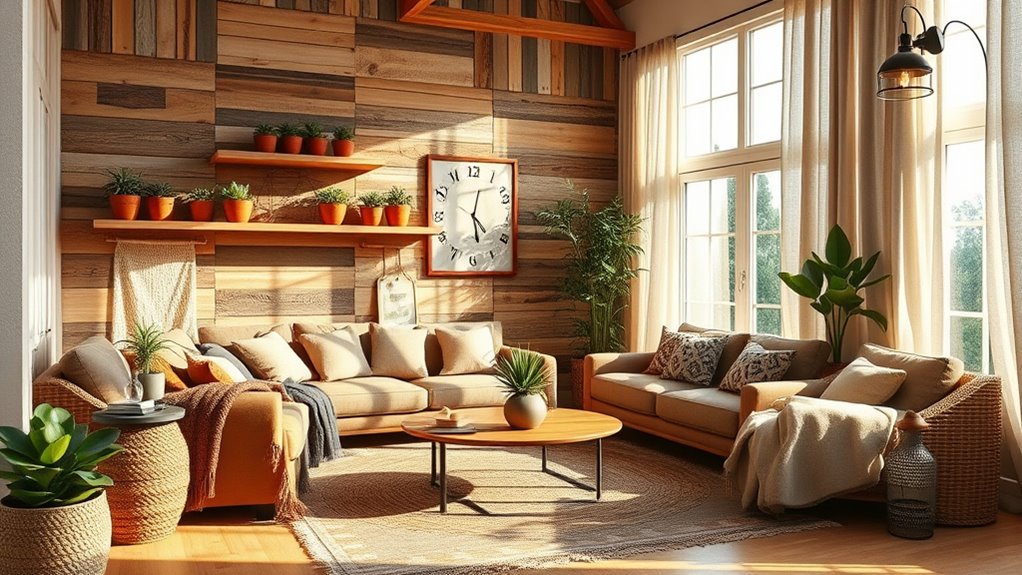
Incorporating reclaimed and natural materials is a key way to create a sustainable boho home that feels warm and inviting. Opt for reclaimed wood to add rustic charm while reducing deforestation and waste. Use natural materials like cork, bamboo, and jute, which are renewable, biodegradable, and improve indoor air quality. Salvaged or upcycled furniture not only lowers your environmental impact but also adds unique character. Choose eco-friendly finishes and low-VOC paints for reclaimed surfaces to minimize chemical emissions and promote a healthier space. Incorporate biodegradable textiles and natural fibers in rugs and cushions to support sustainable sourcing and enhance the organic, relaxed vibe of your boho decor. Incorporating natural materials can also elevate the aesthetic by blending seamlessly with other eco-friendly elements. Exploring Vetted eco-friendly electric bike conversion kits can inspire sustainable transportation options that align with your eco-conscious lifestyle. Incorporating sustainable materials into your decor not only benefits the environment but also creates a more mindful and harmonious living space. Additionally, selecting materials with certified eco-friendly sources ensures that your choices meet rigorous environmental standards and support responsible harvesting practices.
Enhancing Energy Efficiency With Smart Technologies
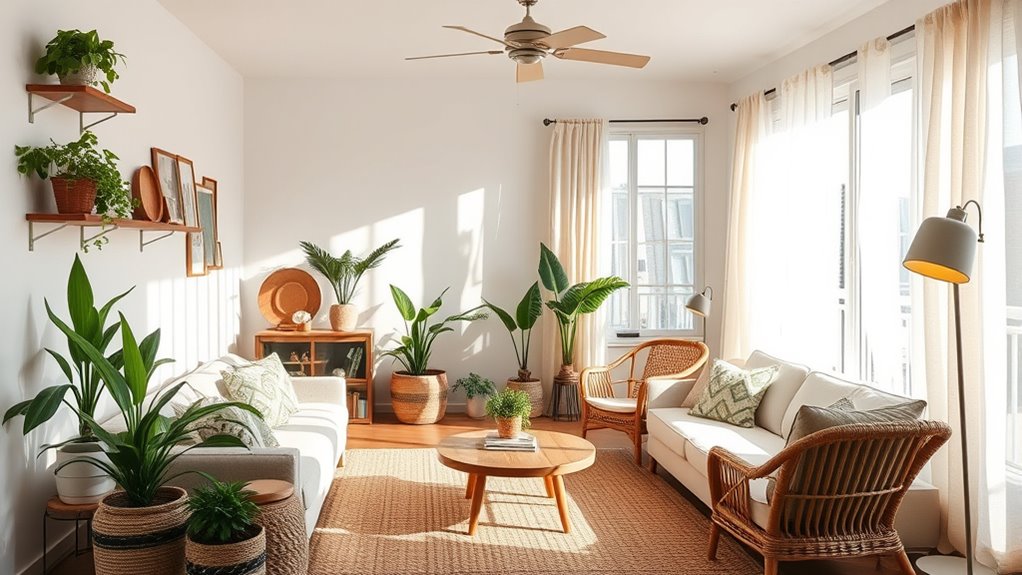
Enhancing your boho home’s energy efficiency is easier than ever with smart technologies that automate and optimize energy use. Smart thermostats adjust temperatures based on occupancy patterns, reducing energy consumption by up to 10% annually. Installing programmable lighting and motion sensors cuts lighting energy use by 25-30%, while energy-efficient smart devices with Energy Star ratings lower bills by 15-20%. Real-time energy monitoring systems give you detailed data, helping you identify savings opportunities and make targeted adjustments. Incorporating renewable energy, like solar-powered outdoor lights and security cameras, boosts sustainability and lowers reliance on grid power. Upgrading to LED lighting and integrating smart devices not only enhances energy efficiency but also aligns with your eco-friendly lifestyle, making your boho home both stylish and sustainable. Mad Tasting offers insights into innovative solutions to further optimize your energy conservation efforts.
Sustainable Decor and Textile Choices
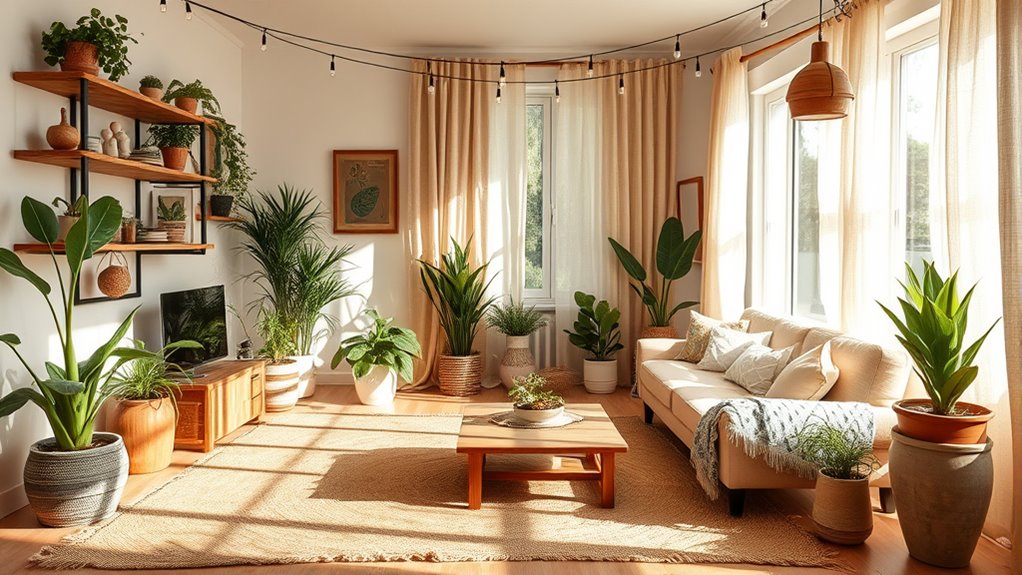
Choosing textiles made from organic fibers like hemp, organic cotton, or bamboo helps reduce chemical use and supports sustainable farming. Supporting brands that use low-impact dyes and eco-friendly printing methods further decreases environmental impact. Recycled or upcycled textiles, such as reclaimed fabrics or vintage pieces, give new life to materials and keep waste out of landfills. Incorporating eco-friendly materials like these not only benefits the environment but also promotes healthier indoor air quality. Additionally, selecting payment processing options that prioritize security can help protect your transactions when shopping for sustainable home goods online. Implementing energy-efficient heating and cooling systems, such as heat pumps, can further reduce your home’s carbon footprint and enhance overall sustainability. Utilizing renewable energy sources like solar panels can significantly lower household energy consumption and support a greener lifestyle, while choosing natural insulation materials can improve energy efficiency without harmful chemicals.
Organic Fabrics and Textiles
Opting for organic fabrics like cotton, hemp, and bamboo allows you to create a stylish home that’s healthier for both you and the environment. These sustainable materials are made from natural fibers grown without synthetic pesticides or fertilizers, reducing chemical runoff and improving indoor air quality. Choosing eco-friendly textiles, especially GOTS certified ones, ensures your textiles meet strict standards for eco-conscious decor and safe dyeing processes. Organic cotton and biodegradable fabrics support sustainable agriculture and promote a circular design approach, minimizing textile waste. Incorporating these sustainable textiles into your home not only elevates your boho aesthetic but also aligns with eco-friendly principles. By prioritizing organic fabrics, you embrace a more mindful, eco-conscious lifestyle that benefits the planet and your well-being.
Recycled and Upcycled Decor
Incorporating recycled and upcycled decor into your home seamlessly blends sustainability with unique style. Recycled decor items like vintage furniture or reclaimed wood accents reduce waste and extend material lifespan, lowering your environmental footprint. Upcycled textiles, such as old curtains or clothing, can be transformed into cushions, wall hangings, or rugs, minimizing the need for new fabric production. Using decor made from recycled glass or metals supports the circular economy and decreases demand for virgin resources. Incorporating secondhand decor not only adds character but also reduces energy consumption associated with manufacturing new items. Additionally, sustainable materials such as organic cotton or hemp can inspire eco-friendly self-care routines that complement your sustainable home. Pairing sustainable textiles like organic cotton or hemp with recycled decor helps create an eco-friendly home that’s both stylish and environmentally conscious. Exploring alternative candle-making techniques, such as wickless or wax-free candles, can further enhance your sustainable living space by reducing waste and chemical exposure. Incorporating low-impact manufacturing practices in your decor choices ensures your home remains environmentally friendly from production to display. Using eco-conscious sourcing methods when selecting materials further supports responsible production practices and reduces your home’s overall ecological impact.
Eco-Friendly Lighting Solutions
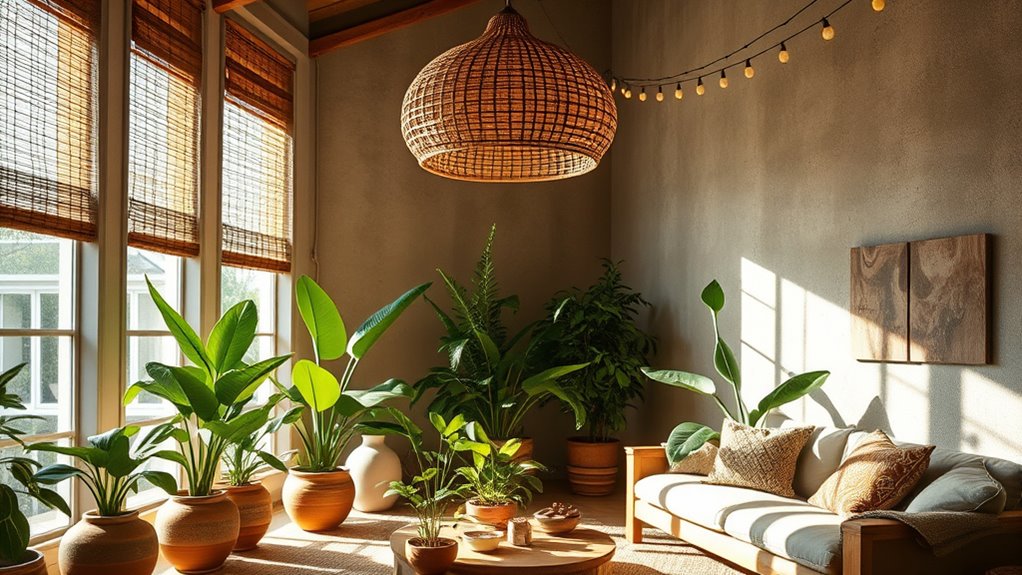
Have you considered how eco-friendly lighting solutions can transform your home into a sustainable haven? Switching to LED lighting reduces energy consumption by up to 75% and offers a lifespan of over 25,000 hours, making it both efficient and long-lasting. Solar-powered lights, whether indoors or outdoors, harness renewable energy to cut reliance on grid electricity and lower greenhouse emissions. Incorporate daylight sensors and dimmer switches to optimize natural light and minimize energy use by up to 30%. Choose low-VOC fixtures and eco-certified lighting to improve indoor air quality and support healthier living. Recycled fixtures add boho charm while reducing waste. By selecting sustainable materials and energy-saving bulbs, you create a stylish, eco-friendly space that’s both beautiful and responsible.
Low-Impact Outdoor and Garden Upgrades
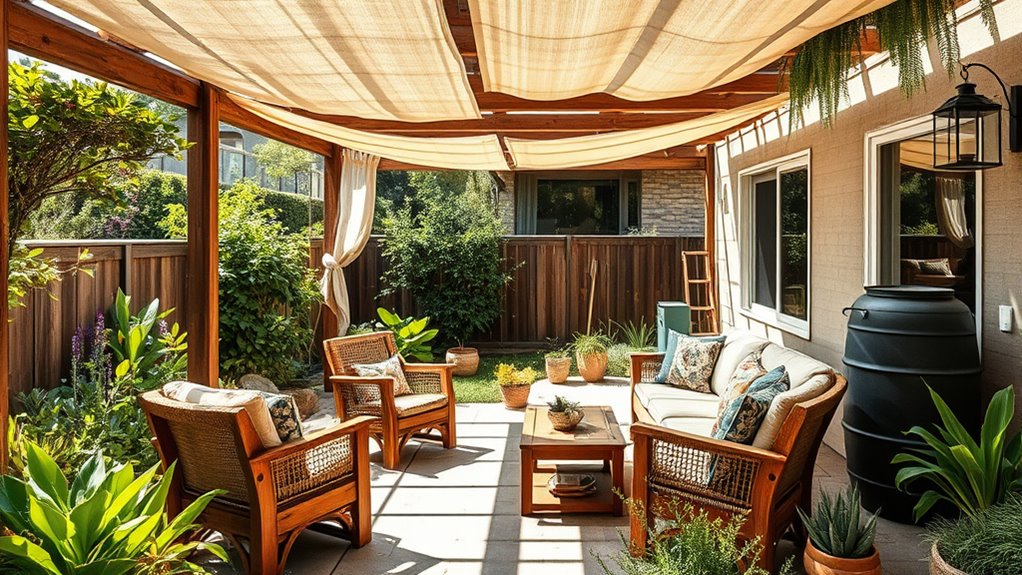
Enhancing your outdoor space with low-impact upgrades not only boosts its beauty but also aligns with your eco-friendly home goals. Incorporate native plants to cut water use by up to 50% and support local ecosystems. Use permeable surfaces like reclaimed wood, gravel, or recycled concrete for pathways and patios to reduce runoff and environmental impact. Installing rainwater harvesting systems allows you to collect and utilize up to 80% of outdoor water, decreasing reliance on municipal supplies. Add green roofs or vegetated terraces to improve insulation, absorb rainwater, and boost biodiversity. Choose sustainable outdoor lighting, such as solar-powered lights, that operate on renewable energy. Additionally, selecting headphone jacks that are compatible with various devices can enhance your outdoor entertainment options while minimizing electronic waste. Understanding cost behavior analysis can help you optimize your budget for these upgrades, ensuring cost-effective eco-friendly improvements. These eco-friendly garden upgrades promote water conservation while creating a vibrant, sustainable outdoor living space.
DIY Projects for a Greener Living Space
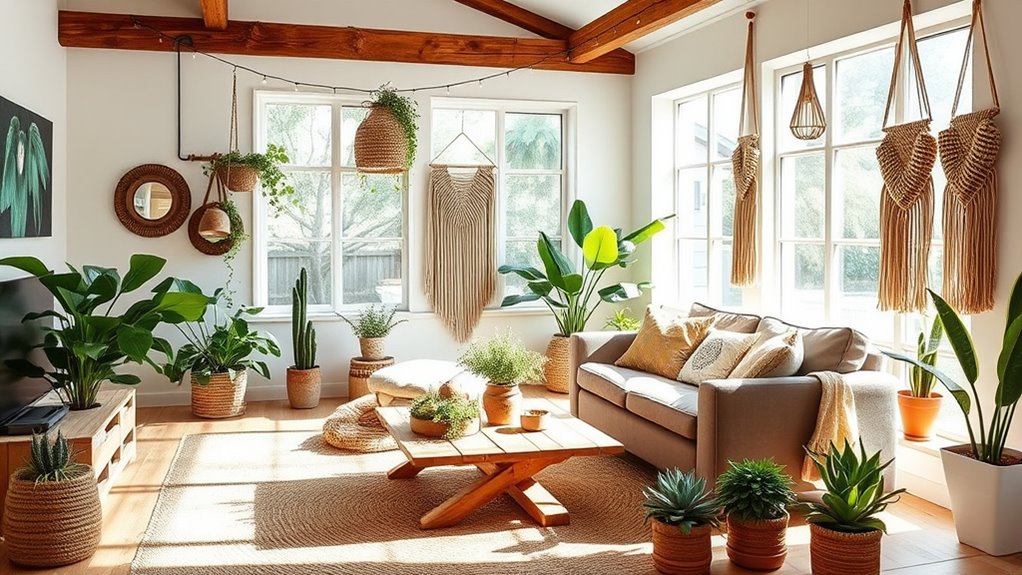
Transforming your living space into a greener haven is easier than you might think with simple DIY projects. Using recycled materials and upcycling old furniture allows you to create eco-friendly home decor that’s both unique and sustainable. For example, repurposing vintage fabrics, reclaimed wood, or biodegradable paper into wall art supports environmentally friendly design. Building planters from repurposed containers like glass jars, tin cans, or wooden crates promotes sustainable gardening indoors and outdoors. Upcycling pallets or scrap wood into furniture not only reduces waste but also adds a natural boho touch. When you use natural, non-toxic adhesives, paints, and sealants, your space becomes healthier and more energy-saving. Selecting sustainable materials for your DIY projects ensures minimal environmental impact and long-lasting results. Incorporating positive thinking into your eco-friendly lifestyle can motivate you to stay committed to sustainable practices. Exploring innovative energy-saving tips can further enhance your home’s eco-friendliness and reduce your carbon footprint. Researching energy-efficient appliances can help you choose the right technology to minimize electricity consumption in your household. Additionally, choosing a merchant account with energy-efficient features can support your eco-conscious living by minimizing electronic waste and promoting responsible technology use. These DIY projects empower you to craft a beautiful, eco-conscious home with minimal impact on the environment.
Choosing Responsible and Local Suppliers
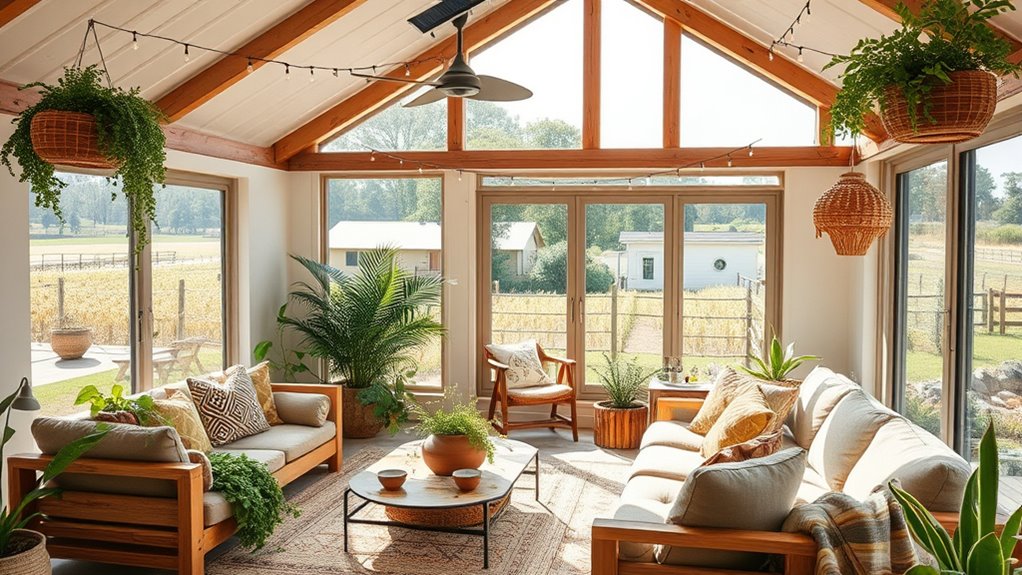
Choosing responsible and local suppliers is essential for creating an eco-friendly home that genuinely supports sustainability. Supporting local suppliers and artisans reduces transportation emissions and bolsters community sustainability. Prioritize vendors with eco-certifications like FSC, Green Seal, or Energy Star, which ensure environmentally responsible sourcing. Seek out regional manufacturers offering recycled or upcycled materials to minimize your carbon footprint. Verify that suppliers follow fair labor practices and sustainable production methods, aligning with regional regulations. Being aware of affiliates and disclosures helps ensure transparency in your purchasing decisions. Additionally, understanding retirement planning can contribute to long-term financial sustainability, enabling you to invest more responsibly in eco-friendly home upgrades. Incorporating sustainable materials into your renovations not only benefits the environment but also enhances the durability and health of your home. Developing an awareness of creative practice can inspire innovative ways to incorporate eco-friendly features into your space.
Frequently Asked Questions
How Do I Verify the Sustainability Claims of Eco-Friendly Materials?
When verifying sustainability claims, start by checking certifications like FSC, ENERGY STAR, or Green Seal, which guarantee the materials meet eco-friendly standards. Research the manufacturer’s transparency about sourcing and production processes, and look for third-party audits or reviews. Don’t hesitate to ask vendors for detailed info about their materials’ lifecycle and environmental impact. This way, you confidently choose genuinely sustainable options for your home.
What Are Cost-Effective Ways to Upgrade Insulation Naturally?
You can’t afford to ignore the power of natural insulation, which can cut your energy bills dramatically! Use thick wool, recycled denim, or cellulose made from shredded paper and plant fibers—these materials are not only budget-friendly but also super effective. Fill your walls and attic with these eco-stars, and watch your home stay cozy year-round while your costs plummet. It’s like giving your house a warm, green hug!
How Can I Incorporate Eco-Friendly Plants Into My Decor?
You can incorporate eco-friendly plants into your decor by choosing a variety of sustainable, non-toxic, and locally grown options. Place low-maintenance plants like pothos or succulents in natural fiber pots or woven baskets to enhance your boho vibe. Use wall-mounted planters or hanging baskets to maximize space and add visual interest. Regularly care for your plants to improve air quality and create a calming, eco-conscious atmosphere in your home.
Are There Energy-Saving Tips Suitable for Rental Properties?
Did you know that renters can reduce energy bills by up to 15% with simple adjustments? You can use energy-efficient LED bulbs, install removable window films, or use smart power strips to cut standby power. Opt for portable, energy-saving appliances and unplug devices when not in use. These tips are easy to implement, cost-effective, and won’t violate your lease, helping you save money and reduce your carbon footprint.
How Can I Repurpose Existing Furniture Sustainably?
You can repurpose existing furniture by giving it a fresh look with paint or new hardware, making it feel new and personalized. Consider reupholstering or adding new cushions to update seating. You might also repurpose furniture for different uses, like turning an old dresser into a storage bench. These simple changes reduce waste, save money, and add a unique, eco-friendly touch to your home decor.
Conclusion
By choosing reclaimed woods, smart tech, and eco-friendly decor, you can create a stylish, sustainable home that’s good for the planet. Some might think these upgrades are costly or complicated, but imagine replacing your old bulbs with energy-saving LEDs or adding a cozy outdoor garden with native plants—simple steps that make a big difference. Your eco-friendly boho space isn’t just beautiful, it’s a conscious choice for a greener, more vibrant lifestyle.


